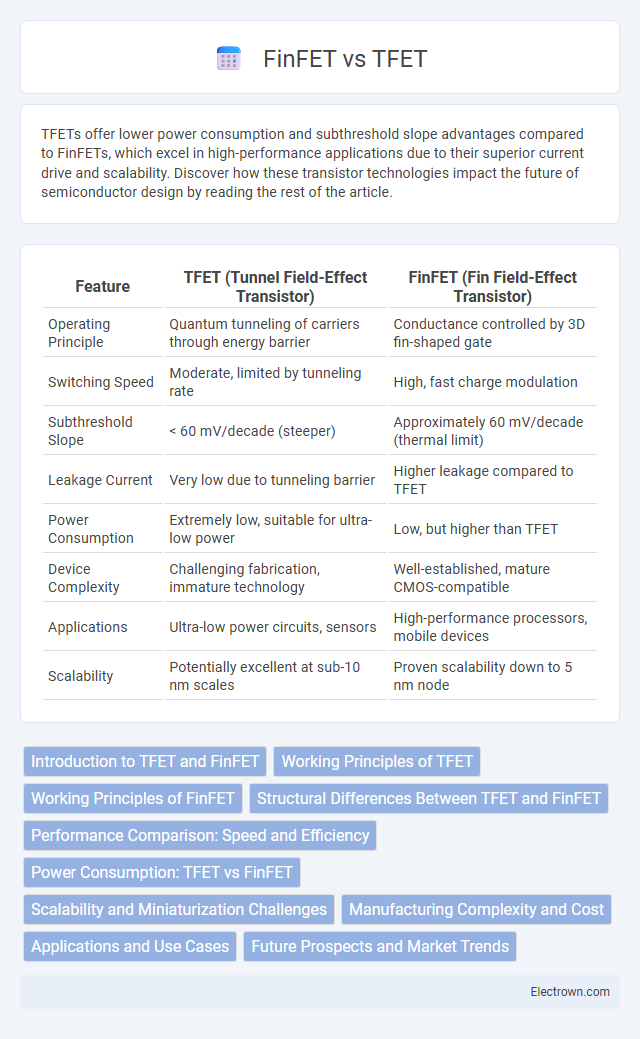TFETs offer lower power consumption and subthreshold slope advantages compared to FinFETs, which excel in high-performance applications due to their superior current drive and scalability. Discover how these transistor technologies impact the future of semiconductor design by reading the rest of the article.
Table of Comparison
| Feature | TFET (Tunnel Field-Effect Transistor) | FinFET (Fin Field-Effect Transistor) |
|---|---|---|
| Operating Principle | Quantum tunneling of carriers through energy barrier | Conductance controlled by 3D fin-shaped gate |
| Switching Speed | Moderate, limited by tunneling rate | High, fast charge modulation |
| Subthreshold Slope | < 60 mV/decade (steeper) | Approximately 60 mV/decade (thermal limit) |
| Leakage Current | Very low due to tunneling barrier | Higher leakage compared to TFET |
| Power Consumption | Extremely low, suitable for ultra-low power | Low, but higher than TFET |
| Device Complexity | Challenging fabrication, immature technology | Well-established, mature CMOS-compatible |
| Applications | Ultra-low power circuits, sensors | High-performance processors, mobile devices |
| Scalability | Potentially excellent at sub-10 nm scales | Proven scalability down to 5 nm node |
Introduction to TFET and FinFET
TFET (Tunnel Field-Effect Transistor) and FinFET (Fin Field-Effect Transistor) are advanced semiconductor devices designed to enhance transistor performance and reduce power consumption. TFET operates using quantum tunneling to switch states, enabling lower voltage operation and improved energy efficiency, whereas FinFET features a three-dimensional fin-like structure that provides better control over the channel, reducing leakage current and improving switching speed. Understanding these technologies helps you choose the appropriate transistor type for low-power or high-performance applications in modern integrated circuits.
Working Principles of TFET
Tunnel Field-Effect Transistors (TFETs) operate based on band-to-band tunneling, where carriers quantum mechanically tunnel through a barrier from the source to the channel, allowing for lower subthreshold swing and reduced power consumption compared to traditional devices. Unlike FinFETs, which rely on the electrostatic control of a three-dimensional fin-shaped channel to modulate current flow, TFETs utilize a gate voltage to modulate the energy band alignment, enabling steep switching characteristics. This principle enables TFETs to achieve high energy efficiency and improved scalability in ultra-low-power applications.
Working Principles of FinFET
FinFET operates by using a three-dimensional structure where the gate wraps around a thin silicon fin, providing enhanced control over the channel compared to planar transistors. This multi-gate configuration reduces short-channel effects and leakage currents, improving switching performance and power efficiency at nanoscale dimensions. The fin's height and thickness directly influence the device's drive current and electrostatic control, making FinFET ideal for advanced semiconductor technologies.
Structural Differences Between TFET and FinFET
TFET (Tunnel Field-Effect Transistor) features a vertical tunneling junction between the source and channel, enabling carrier transport via band-to-band tunneling, unlike FinFET's multi-gate structure with a fin-shaped channel that enhances electrostatic control. TFET employs a heavily doped p-i-n architecture for efficient tunneling, whereas FinFET uses a tri-gate silicon fin to suppress short-channel effects and improve drive current. The fundamental structural distinction lies in TFET's reliance on quantum tunneling mechanisms contrasted with FinFET's electrostatic gate control around a 3D fin channel.
Performance Comparison: Speed and Efficiency
TFETs exhibit superior energy efficiency compared to FinFETs due to their steep subthreshold slope, enabling lower operating voltages and reduced power consumption. FinFETs outperform TFETs in switching speed because of their higher drive current and mature manufacturing process, making them ideal for high-performance computing applications. In summary, TFETs excel in low-power scenarios, while FinFETs dominate in speed and overall performance efficiency.
Power Consumption: TFET vs FinFET
TFET (Tunnel Field-Effect Transistor) technology offers significantly lower power consumption compared to FinFETs due to its steep subthreshold slope and reduced leakage currents, making it ideal for energy-efficient applications. FinFETs, while providing improved performance and scalability over planar transistors, typically consume more power, especially in standby modes, due to increased gate leakage. Your choice between TFET and FinFET will heavily depend on the power efficiency requirements of your semiconductor design or device.
Scalability and Miniaturization Challenges
TFETs offer superior subthreshold slope control, enabling lower power consumption at reduced scales, but face material and fabrication challenges that limit their scalability below 10 nm nodes. FinFETs, widely adopted in industry, demonstrate robust scalability down to 5 nm with advanced lithography and doping techniques, yet suffer from increased short-channel effects and variability at extreme miniaturization. Overcoming TFET fabrication complexity and enhancing FinFET electrostatic control are critical for future device miniaturization and high-performance applications.
Manufacturing Complexity and Cost
TFETs generally exhibit lower manufacturing complexity due to their simpler gate structure and reduced short-channel effects, potentially lowering fabrication costs compared to FinFETs. FinFETs require advanced lithography and precise 3D fin etching, increasing production difficulty and expenses. Your choice between TFET and FinFET manufacturing will depend on balancing cost efficiency with performance requirements in nanoscale semiconductor devices.
Applications and Use Cases
TFETs excel in ultra-low-power applications such as wearable devices and IoT sensors, where minimizing energy consumption is critical. FinFETs dominate high-performance computing and mobile processors due to their superior switching speed and scalability. Your choice between TFET and FinFET depends on whether energy efficiency or processing power is the priority in your specific use case.
Future Prospects and Market Trends
TFET technology offers significant potential for ultra-low-power applications due to its steep subthreshold slope and reduced leakage currents, positioning it as a promising candidate for next-generation energy-efficient devices. FinFETs currently dominate the semiconductor market with mature fabrication processes and robust performance at nanoscale nodes, but face increasing challenges in scaling beyond 3nm technology nodes. Market trends indicate growing R&D investments in TFETs for IoT and wearable applications, while FinFETs maintain strong demand in high-performance computing and mobile processors.
TFET vs FinFET Infographic

 electrown.com
electrown.com